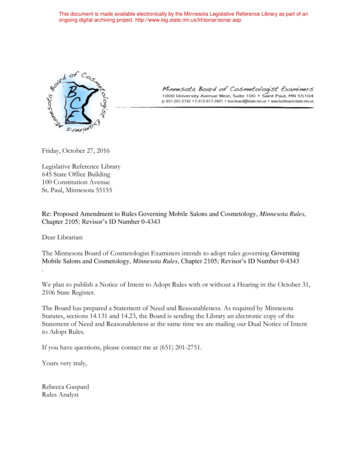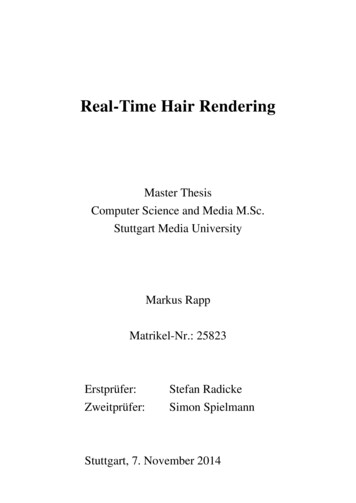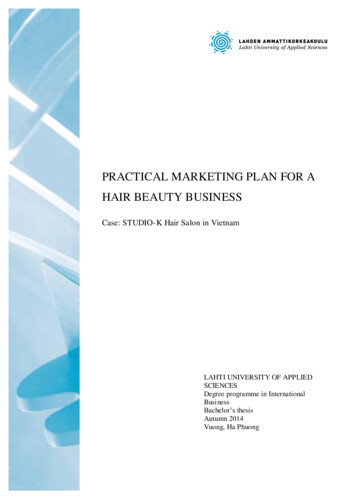
Transcription
HAIRANDGUIDANCE ON PREPARING WORKPLACES FOR COVID-19NAIL SALONS1
Service sector businesses such as hair and nail salons play a criticalrole in Wisconsin, providing goods and experiences that enhancethe quality of life for residents. Locally owned salons contributeto a unique sense of place that brings communities together andattract tourists to spend time in Wisconsin.There are more than 5,000 salons and barbershops in the state,virtually all of which have been completely closed and thus unableto serve their loyal customers due to COVID-19. The closepersonal contact required in personal service situations makes itespecially challenging yet critically important to accommodatethe necessarily social distancing and sanitation in this time. Thisguide includes instructions for personal service providers includingbarbershops and hair and nail salons looking to take steps to allowtheir businesses to reopen during the COVID-19 pandemic.Keeping employees and customers safe is the number-onepriority for all businesses. Using personal protective equipment(PPE), physical barriers, physical distancing, appropriate cleaningand disinfection procedures, and the other steps described belowcan help salon and other personal service businesses minimizeCOVID-19 transmission in their workplace. To ensure consistencyin keeping you and your employees safe, this document isintended to provide general guidelines and best practices for hairand nail salons and barbershops looking to take steps to opentheir facility when it is time to do so. In addition, please see the“General Guidance for All Businesses” document for guidancethat applies to all industries, and please consult the other availableindustry guides as relevant for your specific business type.Recommendations for Hairand Nail SalonsEmployee health and hygieneCarry a towel. If you get the urge to sneeze or cough, youshould cover your nose, mouth and mask; attempt to delaythe urge to sneeze or cough; and immediately leave thebuilding or get as far away as possible from clients andcoworkers. Wash hands and face thoroughly beforereturning to work.Employees who have a fever or other symptoms of COVID-19should be instructed to stay home. Consider a wellnesscheck of employees each day.Maintain an adequate supply of paper towels, soap and handsanitizer to allow proper hand hygiene among employees.Clean and disinfectProvide tissues for proper cough/sneeze etiquette andno-touch disposal receptacles.Maintain an adequate supply of cleaning and disinfectionproducts. The U.S. Environmental Protection Agency (EPA)has developed a list of products that meet EPA criteria for useagainst the COVID-19 virus. Review product labels and safetydata sheets and follow manufacturer specifications.Employees should take these steps:Wash hands on arrival at work, after each client, aftertouching your mask, after using the restroom and whenleaving work.Wear a mask at work at all times.If a face shield is provided, wear it when working with clientsand disinfect it appropriately.Let your employer know if you have concerns about thePPE that is being provided.PROTECT2WASH OFTENDISINFECTCAUTION
If surfaces are dirty, they should be cleaned using adetergent or soap and water prior to disinfection.Use a clean cape for each client. Ideally, have sufficientnumber of capes on hand for all clients per day to avoidreuse. Launder all used capes at the end of each day.Consider using a checklist or audit system to track howoften cleaning is conducted.Smocks, towels, work clothing etc., should be placedin plastic bags after each use, treated as potentiallycontaminated, and laundered by washing and drying onthe highest temperature setting allowable for the fabric.Identify staff members who will be responsible forensuring regular cleaning and disinfection.Wipe down/disinfect all cutting and other tools (e.g., combs,brushes) between clients and at the beginning and end ofeach shift. Alternatively, stylists should havean ample supply of combs and other tools at theirdisposal (all implements should then be disinfectedand washed at the end of the day).Increase the cleaning frequency of restrooms, andconsider design changes:Doors to multi-stall restrooms should be able tobe opened and closed without touching handles iffeasible. Consider adding a foot pull to the door if oneis not already in place. Place a trash can by the door ifthe door cannot be opened without touching the handle,so restroom users may use a paper towel to cover thedoorknob/handle.All nail tools should be disinfected between use or besingle-use only.Consider allowing returning clients the option of buyingtheir own nail tool kit for repeated use.For single-occupancy restrooms, provide signageand materials (paper towels and trash cans) forusers so they can avoid touching handles. Considerproviding a key so usage can be better monitoredand disinfection controlled.Hairdressing and salon chairs, combs and other hairstylingtools, door handles, tables, countertops and point-ofpurchase credit card payment stations should bedisinfected after each client.Minimize the sharing of work tools and equipment such asphones, keyboards, cash registers, point-of-sale devices.If sharing is necessary, disinfect the equipment before andafter each use.If toilet lids are present, post signs indicating lids shouldbe closed before flushing.Post signs asking client and employees to wash handsbefore and after using the restroom.Consider covering chairs in a non-porous material for easycleanup, or use a disposable cover as is used in dental ormedical offices.Provide paper towels and disconnect or tape off handair dryers.Physical distancingClean HVAC intakes and returns daily.Provide handwashing stations at the front of the salon, orif handwashing is not feasible for all clients who enter theshop, provide hand sanitizer. Make hand sanitizer availablefor clients to disinfect their hands thoroughly uponentering and leaving the salon.Limit the number of clients in the shop at one time. Onlyclients that are actually getting their hair or nails done shouldbe inside the salon. Clients should not check in at a frontdesk or wait in a reception area.Consider establishing a process for clients to remain in theircars or otherwise outside of the salon until they are notifiedDuring procedures, clients should wear paper neck stripsprovided by the stylist to help ensure proper hygiene.3
(either by text or phone call) that their chair is open and hasbeen properly disinfected from the previous client.Limit face-to-face interaction as much as possible whencutting or otherwise working on hair (i.e., stand behind theclient as much as possible).Since the six-foot social distance guideline is not practical innail salons, minimize facial contact by wearing a face shield orinstalling a plastic partition between the employee and clientwith ample space cut out where hands or feet can be slidunderneath to conduct the manicure or pedicure.Establish prepay systems or self-checkout systems (e.g.,portable credit card portals at each chair that are cleanedafter each use). Discourage the use of cash.If a prepay system is not feasible, consider using a plexiglasspartition between cashiers and clients.Clients should use their own pens to sign credit cardauthorizations. If a pen provided by the salon must be used,it should be disinfected after each use. The same applies fortouchpad use.Establish an isolated area for all delivery companies to dropoff materials and supplies (i.e., minimize their presence inthe salon).As ventilation is being evaluated, all nail salons shouldconsider upgrading existing ventilation to include locallyexhausted nail tables. Several states already require thisspecial ventilation for control of nail salons’ toxic airpollutants, and this ventilation may also be helpful inimproving general air quality.Face masks and cloth face coveringsSupply face masks or cloth face coverings for all employees.Instruct your employees in how to properly put on andremove a facemask or cloth face covering. The U.S. Centersfor Disease Control and Prevention (CDC) provides guidanceon how to properly wear a face covering and offerstutorials for how to make one.If gloves are used, ensurethey are changed after each client and that staff wash theirhands after each client.Client health and safetyUse social media and other communication to educateclients on the steps being taken for their protection andwhat they need to do to protect staff as well.To the extent possible, clients should wear face coveringswhen receiving services.Here’s what to ask of clients via communications and whenthey visit your salon:Consider making face masks available to clients who do nothave one for use at your salon. Considerations should bemade for members who are unable or unwilling to wear amask or cloth face cover.If you are sick, stay home. If you have a temperature,stay home. If someone in your house is sick, stay home.If you have allergies and can’t control sneezing, stayhome. In anyof these cases, reschedule your appointment to a laterdate.Engineering controlsConsult an HVAC professional about increasing ventilationrates, the percentage of outdoor air that circulates into thesystem, maintaining the relative humidity at 40 to 60% andplacing restrooms under negative pressure.Wear a mask, preferably the style that wraps behind theears (certain mask styles may interfere with the performance of the haircut or color treatment).Workplaces should review guidance from the AmericanSociety of Heating, Refrigerating and Air-ConditioningEngineers to consider when discussing ventilation changeswith HVAC professionals.Do not enter the salon until your chair is open and it hasbeen disinfected.If fans such as pedestal fans or hard-mounted fans are usedin the salon, take steps to minimize air from fans blowingdirectly from one person toward another. If fans are disabledor removed, employers should remain aware of possible heathazards and take steps to mitigate them.Wash your hands before and after you leave the salon.If handwashing is not possible, use hand sanitizer whenyou enter and before you leave the building.Limit the items you touch in the salon to items youselect to purchase.As much as possible, maintain a distance of at least sixfeet from other clients and other employees when walking through the salon.4
If you get the urge to sneeze or cough, put on yourmask (if not already wearing it) and cover your nose,mouth and mask with a napkin or handkerchief. Washyour hands and face thoroughly before returning to youractivity.Businesses have the right to refuse service to anyoneexhibiting symptoms or not following salon guidelines.A questionnaire or checklist may be used to clear clients toenter the salon.Post signage on the front door letting clients know aboutchanges to your policies and instructing them to stay away ifthey are experiencing symptoms of COVID-19.Remove all unnecessary touchpoints, especially those thatcannot be sanitized. Examples include removing paper visitorlogs, discontinuing the use of pens to sign receipts (cashlessand contactless transactions are recommended), and usingdrop boxes for hand delivery items.Utilize disposable instead of reusable items whenever possible. Provide adequate trash receptacles and increase trashremoval frequency to accommodate additional waste.When exchanging paper and coin money:Do not touch your face afterward.Ask clients to place cash on the counter rather thandirectly into your hand.Place money on the counter (not in hand) whenproviding change back to clients.Wipe counter after each client at checkout.Employee training, supportand communicationCommunicate with workers about actions being taken toprevent COVID-19 exposure through routine meetings andemails.Provide instruction and training to employees, includingthese topics:How to handle their work clothing properly at home iflaundry service is not provided.How to safely put on and remove gloves.Require all clients to wash their hands or use hand sanitizerbefore you work on their nails.Cleaning and disinfecting surfaces according to productspecifications.As an initial step with each client, thoroughly wash andtowel-dry their hair before performing any work. For someservices (for example, color) this may not be feasible. Consider asking clients to wash their hair prior to arrival for theseservices.Correct use and wear of face masks or coverings.Physical distancing changes.Employee illness reporting.Services should be provided by appointment only.Train employees in how to recognize areas and practices thatpose a risk for spreading the virus. Define a process to quicklyreview concerns and provide mitigation strategies. Includea recognizing/reporting module in your COVID-19 responseplan.No client should remain in a waiting area prior to receivingservices.Consider assigning one or more employees to monitorcompliance with workplace guidance.Common-use areas (such as lounge areas, courtesy food andbeverage bars, and child play areas) should be closed if it isnot possible to practice proper social distancing and sanitizing. Remove magazines and newspapers from these areas.Post signage to remind your employees of safe practices,such as distancing, hand hygiene and cough/sneezeetiquette.Business operationsThe facility must maintain adequate records of its clients,including names, telephone numbers and visit dates, in casecontact tracing becomes necessary. The facility must alsomaintain accurate work records of its staff to assist withcontact tracing if necessary.Encourage clients to use touchless payment options whenavailable. Minimize handling cash, credit cards, reward cardsand mobile devices.Additional resourcesCDC Interim Guidance for Businesses and Employers to Plan and Respond toCoronavirus Disease 2019 (COVID-19): www.cdc.govCDC General Business Frequently Asked Questions: www.cdc.govAmerican Industrial Hygiene Association Back to Work Safely webpage (containsguidance for hair and nail salons and other sectors): www.backtoworksafely.orgOccupational Safety and Health Administration Guidance on Preparing Workplacesfor COVID-19: https://www.osha.gov/Publications/OSHA3990.pdfIN PARTNERSHIP WITH WISCONSIN’S REGIONALECONOMIC DEVELOPMENT ORGANIZATIONS:7 Rivers Alliance CentergyMadison RegionEconomic PartnershipMilwaukee 7Momentum WestProsperity Southwest Grow North The New NorthVisions Northwest5.7.2020
Hairdressing and salon chairs, combs and other hairstyling tools, door handles, tables, countertops and point-of- purchase credit card payment stations should be disinfected after each client. Minimize the sharing of work tools and equipment such as phones, keyboards











